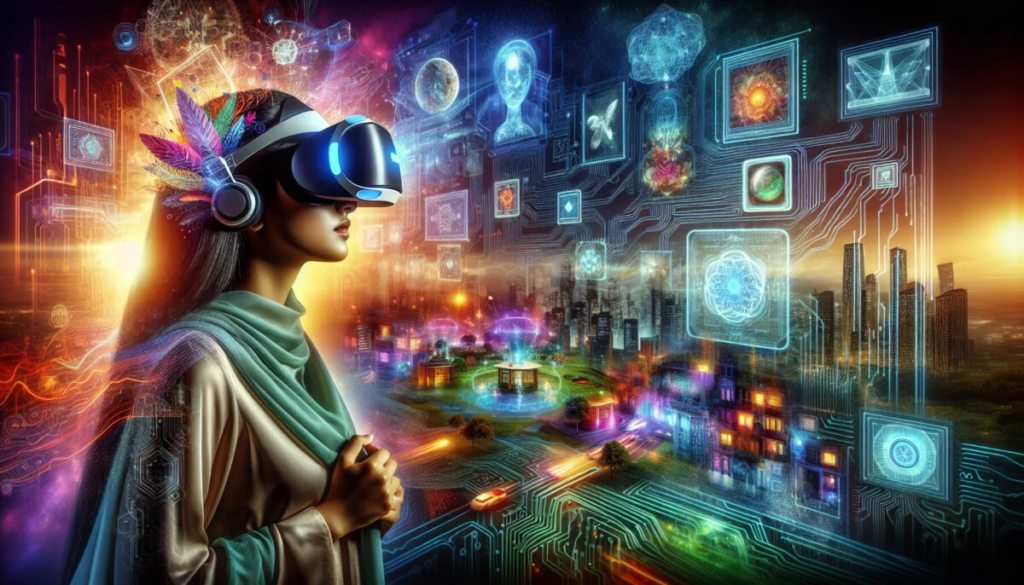
The metaverse—a persistent, interconnected, immersive digital world—is no longer a distant science fiction concept. Thanks to advancements in virtual reality (VR), augmented reality (AR), blockchain, and artificial intelligence (AI), we are rapidly entering a future where digital experiences mirror or even surpass the physical world in interactivity and scale.
At the heart of this transformation lies Generative AI—a class of artificial intelligence capable of autonomously creating content, from 3D environments to lifelike avatars and synthetic voices. The fusion of Generative AI and the metaverse is revolutionizing how virtual worlds are built, navigated, and personalized.
This blog delves into how Generative AI is shaping the metaverse, its applications, benefits, challenges, and what the future holds.
What Is the Metaverse?
The metaverse is an expansive digital ecosystem comprising immersive, 3D virtual spaces where users interact with each other and the environment in real time. It spans gaming, socializing, commerce, work, and education—offering a seamless digital layer parallel to our physical reality.
Think of it as a blend of:
- Virtual reality (VR) and augmented reality (AR)
- Persistent digital identities and environments
- Real-time interaction and social networking
- Decentralized economies using blockchain and NFTs
The challenge? Creating and maintaining this dynamic, scalable, and engaging universe.
Enter Generative AI.
What Is Generative AI?
Generative AI refers to AI models capable of producing new content based on learned patterns from vast datasets. These models can generate:
- Images (via DALL·E, Midjourney, Stable Diffusion)
- Videos (via Runway, Synthesia)
- 3D models (using NVIDIA GET3D, Luma AI)
- Text (via ChatGPT, Claude, Bard)
- Music (via Jukebox, Amper Music)
- Code (via GitHub Copilot, Replit Ghostwriter)
In the context of the metaverse, Generative AI becomes the creative engine, automating and accelerating the creation of rich, complex digital experiences.
Core Applications of Generative AI in the Metaverse
1. Creating Immersive 3D Environments
Designing vast, detailed virtual worlds manually is time-consuming and expensive. Generative AI can automate:
- Terrain generation (forests, cities, alien planets)
- Weather patterns and lighting effects
- Procedural architecture (custom buildings or cities)
AI tools like NVIDIA Omniverse and Unreal Engine’s AI plugins enable developers to generate photorealistic environments at scale, reducing costs while maintaining creative flexibility.
2. Avatar Generation and Customization
In the metaverse, digital identity matters. Generative AI powers:
- Personalized avatars that mirror real facial expressions and body language
- Clothing and accessories tailored to users’ style
- Instant animation of avatars based on voice or gesture inputs
With tools like Ready Player Me and Zepeto, users can create expressive, lifelike avatars in seconds, thanks to generative models trained on human features and fashion trends.
3. AI-Generated NPCs and Social Interactions
Non-player characters (NPCs) in the metaverse are no longer static. Generative AI gives them:
- Lifelike conversations via large language models (LLMs)
- Dynamic personalities and emotional responses
- Autonomous behavior and decision-making
Imagine walking into a virtual store and being greeted by an AI assistant that understands your preferences and can engage in a human-like conversation.
4. Generative Design for Digital Assets
Every metaverse needs countless digital assets—furniture, vehicles, artifacts, etc. Generative AI can:
- Design unique items with minimal human input
- Suggest styles based on user preferences
- Adapt assets in real time to different use cases (e.g., resizing a chair for VR)
AI-driven asset marketplaces may soon allow users to generate, mint, and sell their creations as NFTs.
5. Content Creation and Storytelling
Generative AI can co-create:
- Virtual storylines and quests in games
- Immersive training modules for enterprise users
- Educational simulations and museum tours
Storytellers and game designers use AI tools like Inworld or ChatGPT to generate plot branches, dialogue trees, and lore, making experiences richer and more interactive.
6. Real-Time Translation and Voice Synthesis
With global users converging in one digital space, communication is key. Generative AI provides:
- Real-time multilingual translation
- Voice cloning and lip-syncing for avatars
- Emotion-driven voice generation
This ensures inclusive, seamless interaction between users from different regions and cultures.
Future Possibilities
1. Co-Creation Platforms
The future metaverse will likely feature AI-powered design tools where users and machines collaborate to build virtual spaces, items, or narratives.
2. Autonomous AI Societies
Imagine AI-generated NPCs running their own virtual cities with economies, governance, and culture—interacting with human users organically.
3. AI-Enhanced VR Learning
Generative AI could create real-time training simulations, adaptive classrooms, and virtual labs tailored to each learner’s pace and style.
4. Cross-Platform Interoperability
AI will help translate assets and experiences across different metaverse platforms, creating a seamless digital universe.
How Creators and Brands Can Leverage This Today
For Developers:
- Use AI to speed up environment and character creation
- Implement conversational AI in VR/AR applications
For Artists:
- Generate concept art, textures, or music using AI tools
- Customize assets for virtual galleries or NFT showcases
For Businesses:
- Build AI-powered virtual showrooms or stores
- Create digital twins of products for immersive marketing
For Educators:
- Design AI-driven simulations or learning adventures
- Personalize lessons using user interaction data
The synergy between Generative AI and the metaverse is unlocking a new era of digital expression, interaction, and creation. While there are challenges ahead, the opportunities are vast—from personalized learning to dynamic social worlds and AI-driven creativity.
Generative AI is not just a tool; it’s becoming the co-architect of the metaverse, helping to build and breathe life into our next frontier of digital living.